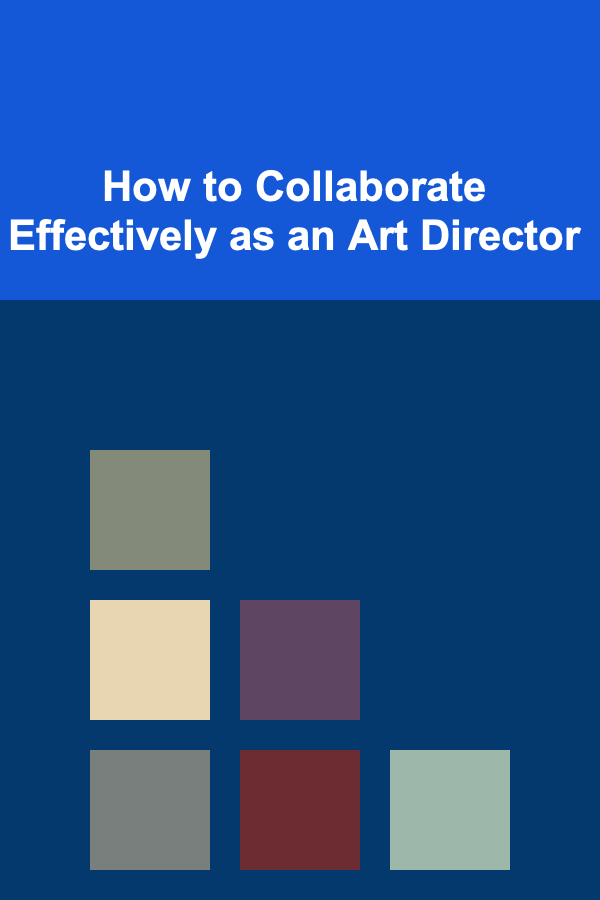
How to Collaborate Effectively as an Art Director
ebook include PDF & Audio bundle (Micro Guide)
$12.99$7.99
Limited Time Offer! Order within the next:

As an art director, you are responsible for leading a creative team to develop visual concepts that bring ideas to life. Whether in advertising, publishing, film, or any other creative field, the role demands strong leadership, creative vision, and the ability to collaborate effectively with multiple stakeholders. The collaborative aspect of the art director's role is one of the most essential factors in achieving success on any project.
Collaboration as an art director is not just about working with designers or other creatives; it's about connecting with clients, understanding their vision, working with project managers, and interacting with other departments. This article delves into the best practices for art directors to collaborate effectively, ensuring both creative excellence and project success.
The Role of an Art Director in Collaboration
Before exploring the dynamics of collaboration, it's important to understand the art director's primary responsibilities. As an art director, your main goal is to guide the visual direction of a project, ensuring that the final outcome aligns with the client's objectives while maintaining creativity and artistic integrity.
Your role will involve:
- Leading the design team to conceptualize and create visual solutions.
- Communicating effectively with clients and stakeholders to understand their needs.
- Providing feedback and direction to designers and other creatives.
- Managing the project timeline, budget, and scope.
- Ensuring the project stays aligned with the brand's aesthetic and values.
Effective collaboration is critical to performing these tasks efficiently and ensuring that the project meets expectations. It's about managing relationships, balancing ideas, and making sure that creative work progresses smoothly.
Building Strong Communication Channels
Effective collaboration begins with communication. As an art director, you are often at the center of a creative team, dealing with feedback, brainstorming ideas, and managing expectations. Establishing clear communication is key to ensuring that everyone understands the vision, their responsibilities, and deadlines.
1. Set Clear Expectations
From the beginning of any project, it is crucial to set clear expectations for both the creative team and clients. Outline the project's objectives, desired outcomes, timelines, and any constraints. This helps avoid misunderstandings and sets a clear direction for everyone involved.
Actionable Tips:
- Conduct an initial meeting with all stakeholders to discuss the project scope and deliverables.
- Write down key points from these discussions and share them with the team.
- Establish clear guidelines on feedback, revisions, and decision-making processes.
2. Use Collaborative Tools
In today's digital world, collaborative tools can significantly enhance communication. Tools like Slack, Trello, Asana, or Basecamp help art directors and teams stay connected, share feedback, and manage tasks efficiently. These tools enable quick updates and facilitate discussions in real time, helping avoid delays in communication.
Actionable Tips:
- Encourage your team to use collaborative platforms to communicate feedback.
- Use cloud-based file-sharing systems like Google Drive or Dropbox to allow easy access to assets.
- Ensure that every member knows how to use the tools and follow a consistent workflow.
3. Active Listening
One of the most vital skills in effective collaboration is active listening. Listening carefully to clients, team members, and other stakeholders allows you to fully understand their perspectives and needs. This ensures that the creative direction aligns with everyone's expectations and prevents costly revisions later in the process.
Actionable Tips:
- Encourage open dialogue and allow team members and clients to express their thoughts without interruptions.
- Ask clarifying questions to ensure you fully understand the feedback before acting upon it.
- Restate key points to confirm understanding.
Fostering Creativity Through Collaboration
Collaboration as an art director is not just about executing tasks; it's about creating an environment that fosters creativity. By working closely with your team, brainstorming ideas, and encouraging input from others, you can create a more vibrant, innovative, and successful creative process.
1. Encourage Brainstorming Sessions
Brainstorming is essential in the creative process, and as an art director, you should be facilitating these sessions regularly. Encouraging team members to freely share ideas allows for greater creativity and helps you discover unique solutions that may not have been initially considered.
Actionable Tips:
- Schedule regular brainstorming sessions throughout the project timeline.
- Create a relaxed, open environment where all ideas are valued and discussed.
- Use tools like mind maps, mood boards, or Pinterest to organize and visualize ideas.
2. Involve All Team Members
Effective collaboration involves utilizing the strengths and ideas of everyone on the team, not just the most senior designers. Even junior designers or other team members like copywriters or photographers can contribute valuable insights that can influence the direction of a project.
Actionable Tips:
- Encourage cross-functional collaboration between designers, photographers, and writers.
- Give junior designers opportunities to provide input and pitch ideas.
- Foster a sense of inclusivity, where each team member feels comfortable contributing.
3. Allow Space for Experimentation
In creative work, experimentation often leads to breakthroughs. While it's important to meet the client's expectations, art directors should also make space for testing new ideas, trying new techniques, and taking calculated risks. This can lead to innovative and unique designs that set your work apart.
Actionable Tips:
- Set aside time during the project for creative experimentation and exploration.
- Encourage your team to try different design approaches and styles.
- Be open to failure and learn from mistakes in the creative process.
Managing Conflicting Opinions and Feedback
As an art director, you will inevitably encounter differing opinions about the creative direction of a project. Whether it's from clients, internal stakeholders, or team members, conflicting feedback can derail a project if not managed carefully. Balancing these different perspectives while staying true to the vision is crucial.
1. Respect Client Feedback, but Maintain Creative Integrity
Clients often have a vision that they want to see realized, and it's important to listen to their feedback. However, as an art director, your responsibility is to balance their needs with your creative expertise. At times, you may need to diplomatically push back on certain requests that could compromise the integrity of the design.
Actionable Tips:
- Validate the client's feedback by acknowledging their ideas and concerns.
- Explain your creative reasoning clearly and respectfully when suggesting alternatives.
- Offer creative solutions that align with both the client's needs and your vision.
2. Handle Internal Feedback Constructively
Internal feedback from other departments, such as marketing, development, or management, can also be challenging. It's important to approach these discussions with an open mind while maintaining the vision for the project. Art directors must navigate the intersection between creative ideas and practical business considerations.
Actionable Tips:
- Set clear expectations for feedback during the project's initiation phase.
- Use the feedback as an opportunity to improve and refine the design.
- Ensure that feedback is specific and actionable, rather than vague or overly critical.
3. Find Common Ground in Conflicting Opinions
When conflicting opinions arise, the goal is not to "win" the argument but to find common ground that satisfies everyone involved. This requires compromise, creative problem-solving, and a focus on the overall project goal. An art director must act as a mediator, aligning the team's creative vision with the project's practical objectives.
Actionable Tips:
- Approach conflicts with a collaborative mindset, aiming to find mutually agreeable solutions.
- Ask questions that help clarify the root of the disagreement and guide the team toward a shared understanding.
- Prioritize the project's overall success over individual preferences.
Ensuring Smooth Project Execution
Collaboration as an art director extends beyond the creative phase into project execution. Coordinating with other departments, managing timelines, and staying organized are key to ensuring that the project is completed efficiently and meets the desired goals.
1. Work Closely with Project Managers
Art directors should closely collaborate with project managers to ensure that the project is on track, within scope, and within budget. Project managers can help you stay organized, monitor deadlines, and track milestones, while you focus on creative leadership.
Actionable Tips:
- Regularly check in with project managers to review timelines, budgets, and resource allocation.
- Communicate any potential delays or obstacles early on so that the team can adjust.
- Use project management tools to track progress and ensure that everyone is aligned.
2. Maintain a Balanced Workflow
Managing multiple projects simultaneously is a common challenge for art directors. Balancing workload, priorities, and deadlines requires careful planning and organization. The ability to prioritize tasks and delegate responsibilities is crucial to managing this aspect of collaboration effectively.
Actionable Tips:
- Prioritize tasks based on deadlines, importance, and complexity.
- Delegate tasks to team members based on their strengths and expertise.
- Break down large projects into smaller, manageable tasks and set intermediate deadlines.
3. Provide Regular Updates and Milestones
Throughout the project, provide regular updates to stakeholders, clients, and team members. Share milestones, show progress, and highlight any challenges you may be facing. This keeps everyone informed and ensures that any issues are addressed before they become major problems.
Actionable Tips:
- Schedule regular check-ins with clients and internal stakeholders to share progress and gather feedback.
- Use visual aids like mood boards, wireframes, or prototypes to illustrate progress.
- Address concerns and offer solutions to potential roadblocks early in the process.
Conclusion
As an art director, your ability to collaborate effectively is one of the most important skills you can develop. Whether working with clients, creative teams, or other departments, successful collaboration leads to better ideas, smoother execution, and more impactful creative outcomes. By fostering strong communication, embracing diverse perspectives, and managing differing opinions with respect and professionalism, you can create an environment that allows creativity to thrive and projects to succeed.
Remember, effective collaboration is not just about managing relationships---it's about creating a shared vision and working together to bring that vision to life. With practice and a focus on communication, teamwork, and organization, art directors can ensure that their collaborations lead to successful, innovative projects every time.
Reading More From Our Other Websites
- [Star Gazing Tip 101] Post‑Processing Secrets: Turning Raw Night Sky Shots into Galactic Masterpieces
- [Home Maintenance 101] How to Organize Your Home's Storage Spaces for Better Functionality
- [Organization Tip 101] Must-Have Coastal Accents for Creating a Serene Bedroom Retreat
- [Polymer Clay Modeling Tip 101] How to Develop a Signature Polymer Clay Style That Stands Out in Online Marketplaces
- [Home Budget Decorating 101] How to Repurpose Old Furniture into Upcycled Home Decor
- [Home Renovating 101] How to Negotiate the Best Price for Renovation Materials When Renovating Your Home
- [Organization Tip 101] Upgrading Your Home Lighting: When and Why to Install Programmable Switches
- [Scrapbooking Tip 101] Choosing the Perfect Cardstock: A Guide for Beginner Scrapbookers
- [Home Maintenance 101] How to Maintain Your Home's Exterior Paint to Avoid Fading
- [Organization Tip 101] Mid-Century Modern Furniture: How to Repair and Refinish Wood Surfaces

How to Create a Checklist for Staying Hydrated Throughout the Day
Read More
How To Hydrate Combination Skin Effectively
Read More
How to Make Your Home Safe for Both Pets and Children
Read More
How to Protect Your Investments with Hedging Strategies
Read More
10 Emerging Trends for Sustainability Officers to Watch
Read More10 Tips for Maximizing Your Fertility Tracker Planner
Read MoreOther Products

How to Create a Checklist for Staying Hydrated Throughout the Day
Read More
How To Hydrate Combination Skin Effectively
Read More
How to Make Your Home Safe for Both Pets and Children
Read More
How to Protect Your Investments with Hedging Strategies
Read More